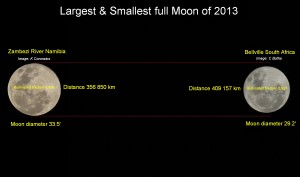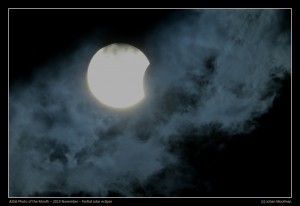January 2014: The largest and smallest Full Moon during 2013 by
The largest Full Moon for 2013 was photographed by Kos Coronaios from the Zambezi River (Namibia), while the smallest Full Moon was captured by Carol Botha from Bellville, South Africa.
The largest Full Moon for 2014 will be seen on January 16.
December 2013: A giant barred spiral galaxy forged in the southern furnace by Leslie Rose
The Fornax Propeller (NGC 1365, Dunlop 562, Bennett 16) is one of only a handful of galaxies that clearly shows spiral structure in modest-sized telescopes. In binoculars it is readily visible as a delicate round glow, 3′ across, which becomes slightly brighter towards the centre.
NGC 1365 is a barred spiral galaxy of gigantic proportions, spanning some 200,000 light years, making it about twice the size of our Milky Way. Located 60 million light years away, it is the most luminous spiral in the nearby Fornax galaxy cluster.
As may be expected from the very bright nucleus, it is classified as a Seyfert galaxy with an active nucleus that presumably hosts a super-massive black hole.
Find out more about NGC 1365 at DOCdb.net, and about Leslie’s image at Astrobin.
November 2013: The last solar eclipse of the year by Johan Moolman
On Sunday, November 03, a partial eclipse was visible over southern Africa, except in the far south. This second (and last) solar eclipse for 2013 was also visible in parts of North America, South America, and Europe, as well as most of Africa and the Middle East.
October 2013: Open cluster in Carina by Brett du Preez.
The brilliant open cluster NGC 3293 was discovered in 1751 by Abbe de Lacaille while observing in Cape Town. It lies near the fabulous eta Carinae Nebula (NGC 3372) within the large diffuse nebula Gum 30. Inspired by this misty background, South African deep-sky observer Carol Botha traces the outline of a hubbly-bubbly pipe amongst the stars of the cluster. The bright orange-red star on its south-western edge (on the right of the cluster in the photo above) contrasts beautifully with the blue-white cluster members. NGC 3293 is a young cluster (10 million years old) that lies in the Sagittarius arm of our Galaxy, some 9 600 light years away.




